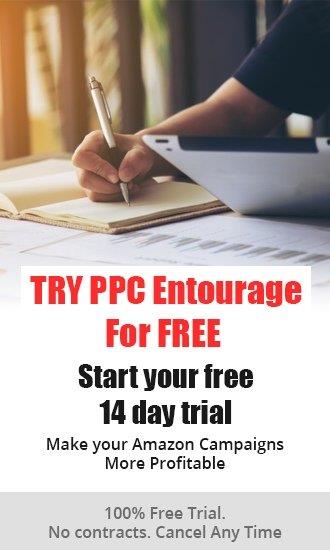The search results page on Amazon is prime real estate, which is why Headline Search Ads are one of the most sought-after and successful advertising options for Amazon sellers. Headline Search Ads (HSAs), also called Sponsored Brands, help increase brand awareness, drive sale conversions, and grow your business.
What are Headline Search Ads and how can you see success with them?
What are Headline Search Ads?
Headline Search Ads are the “Sponsored” banners at the top of the search results page. If you search for just about any keyword, you’ll likely see a banner at the very top of the SERPs with a headline, copy, and multiple images.
This is different than sponsored product listings, which are individual listings that appear within the search results themselves. The HSA is an advertisement at the “headline” of the “search” that markets your brand, as opposed to an individual product.
Headline Search Ads…
- Target specific keywords (auction-based bidding)
- Operate on a pay-per-click basis
- Include up to three ASINs (products)
- Link to a custom landing page
- Include a custom logo, copy, and headlines
Note: HSAs are only open to Professional Sellers who are Brand Registry owners. This ensures that branding and marketing remain consistent for private label products. The seller must also ship to all U.S. addresses and be eligible to win the Buy Box.
What are the benefits of Headline Search Ads?
Because HSAs always appear at the top of the page, customers often consider them the most relevant products for a given keyword. You’re the first brand customers see, which makes you appear to be the most relevant and credible. This authority and exposure will drastically increase visibility, traffic, and conversions.
You are also linking more than one product to the HSA keyword. The banner can include up to three products that are all relevant to what the customer is searching for. This increases your chances that they’ll see something they like and want to click through.
The customer is then brought to a custom landing page specifically made for your brand. This is one of the strongest moments that you can create a brand voice on the Amazon platform (since Amazon generally tries to hold on to its own customers). This additional landing page—aside from your product listings—is also great SEO juice on Amazon and Google.
So how do you create a successful Headline Search Ad campaign?
- Find the best keywords.
Headline Search Ads are targeted by keywords. This means that your banner will only appear when someone searches for the exact keyword for which your ad is bidding.
Keywords are the basis of your copy. All of your content should revolve around your keywords.
For example, you’re paying for the keyword “wheatgrass shots.” Anyone who types “wheatgrass shots” into the Amazon search bar will see your banner at the top. But if they type in “wheatgrass” or “wheatgrass powder,” and you aren’t paying for those terms, your banner might not appear.
Because of this, you want to make sure that your keywords are highly relevant. They should be both directly linked to all products in the ad while also reflecting the language of your target audience.
Start by doing keyword research like you would for a product listing. This will give you an idea of the most relevant terms for your products and brand.
Then, in your Seller Central under Advertising Reports, go to Search Term Report. This is an Amazon resource that helps you find the best keywords for advertisement bidding. Amazon will also present a list of suggested keywords with an associated traffic identifier. This will tell you the popularity of searches for this keyword: low, medium, or high. You can also determine the popularity of the keyword based on the price for bidding. You can use PPC Entourage’s Search Term Expansion module to handle this entire step for you in seconds.
Keyword Bidding
You will then “bid” on keywords that are relevant. Some keywords are more expensive than others based on popularity and traffic. So, you’ll want to find a balance between keyword and budget.
In order to win high-traffic keywords, you need to bid competitively. If the bid is too low, someone else’s ad will appear for that keyword instead. If you have the marketing budget, bidding high on a high-traffic keyword is a strong way to get the widest and most relevant audience.
However, you can also bid on low-traffic keywords. These can give you a more targeted audience for a less costly ad spend.
Let’s say for example, “wheatgrass” is a high-traffic keyword. It might cost you $3 per ad. You’ll likely get more traffic from all “wheatgrass” searchers. But “wheatgrass protein powder” might be a low-traffic keyword that costs $0.80 per ad, but you get a targeted audience of those looking specifically for the protein powder version.
- Write to your audience.
Headline Search Ads are unique in that you are given 50 characters on the search results page aside from the headline. This gives you more room than the typical product listing to attract and sell to your customer.
You want to make sure that you’re fully utilizing this space. Here are our tips for using this advertising space to:
- Write in the way that customers would search in the search bar.
- Write in your brand tone, which should reflect the tone of your customers. Keep in mind the natural language of your prospective shoppers.
- Choose wording and verbiage that aligns with your target keyword.
- Focus on your brands’ number one value proposition. What are you delivering to your customers?
Remember that your copy should intrigue your specific audience to your specific brand. What does your audience need and how do your products meet that need?
Here are two “formula” phrases to try out in your copy:
- Our (product) is (desired outcome) = Our dog food has 3x the vitamins as the leading dog food.
- You will be (adjective) (desired outcome) = You will be shocked when you see how much energy your dog has with our dog food.
Pro-tip: Avoid negative keywords. These tend to deter consumers, while positive language attracts them.
- Use CTA phrases.
You want your copy to drive the customer to action. This means you encourage them to take the next step towards conversion. Use power words that encourage clicks. This could include words like “Shop Now” or “Buy Here.”
The purpose of Headline Search Ads is to get a click through to your custom brand page, so don’t be afraid to use a call to action phrase that focuses on differentiating your brand from your competitors. For example, “Check out our award-winning label” or “See why we’re different.”
Be careful not to include any discount or promotional words here, though. Amazon doesn’t allow temporary deals to appear in Headline Search Ads. For example, you can’t encourage customers to click by writing, “Save 10% now.”
- Split test copy.
You don’t know what copy will be (or is) successful until you test it out. Testing out different content and tracking the metrics is the only way to definitively know how successful your HSA content is.
You might want to set up multiple HSA campaigns at once, each with one variable changed. For example, you might have one ad running with the headline, “Buy our dog food now” and a second ad with the headline, “Treat your dog with Brand Pet Food.” Everything else should remain the same.
Then, you can track the campaign metrics to see the number of clicks and the amount you’ve generated in sales (ACoS). The headline with the greatest clicks and sales is the one you keep— or the one you use in the next test. Then, in the next test, you might try out different images for your products to see which work best.
Tip: Only change one variable at a time. This helps you narrow down what kind of content works best with your audience. You can use Entourage Spotlight to automatically create up to 27 variations and split test them all at once.
Conclusion
Running a pay per click campaign has a lot of variables that you want to control for. If you’re new to Amazon marketing, this can feel overwhelming or challenging.
That’s where PPC Entourage comes in to help you generate greater profits through high-quality Sponsored products and advertisements.
If you’re looking for help in building a consistent, unified branding message across all platforms, check out our friends at Seller’s Choice for help.











